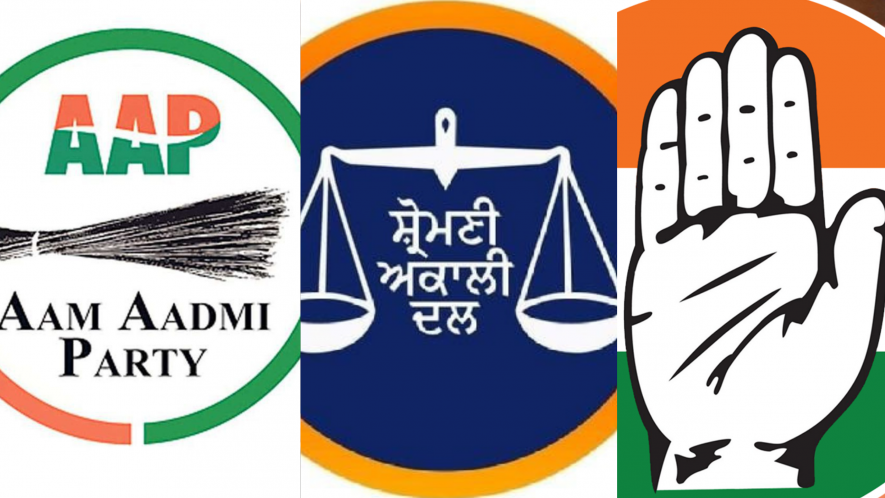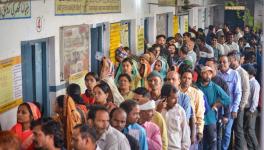Punjab Election: A Desperate Bid to Win on Every Side

In Punjab, beneath political leaders’ calm, smiling faces is a creeping sense of desperation, mainly because their future is uncertain. The state’s two major parties, the Congress and the Shiromani Akali Dal (SAD), are not sure of their victory, and there is an underlying threat of a hung Assembly. They are reassured by their economic might, which has been the key to success in some constituencies, but may not prove decisive in this election. Now, it seems the political tide has taken a slightly different turn in favour of the Aam Adami Party (AAP), a phenomenon quite similar to the 2017 election in Punjab. However, even AAP leaders do not seem sure of their victory because there are undercurrents beyond their control and political tactics.
As it seems, the Bharatiya Janata Party (BJP) and its alliance parties may fail in influencing the post-election scenario, though one never knows the future. That said, the media chases candidates of various parties and spends its energies on understanding and interpreting their chances of electoral victory, but rarely does their focus turn to voters’ behaviour, conduct, and ethics. I am trying to bring out a primarily ignored but grudgingly acknowledged factor of voter vulnerability in certain circumstances. In other words, there is a lot of discussion about the role of money in elections and the corrupt practices of candidates, but rarely is the corruptibility of voters seriously accounted for.
To begin with, it is essential to remember that elections are a recurring phenomenon and, like religious celebrations, have an economy that provides short-term employment opportunities. Much money is spent on election campaigns in ways such as flex signs, placards, transport vehicles, advertisements, social media outreach, etc. During the election period, most taxis remain occupied with work from candidates. Most of the money comes from the candidate’s pocket, so we should assume that such candidates would like to get the same money back through questionable means after getting elected. The expenditures mentioned above are the tip of the iceberg. The more serious irregularities are committed invisibly. Although everybody seems to know, these are not adequately analysed as a mammoth system of corruption involving the politicians and the voters. I will illustrate it by describing the scenario in Punjab.
The Congress party and the SAD have been alternatively forming governments since 1966 when the Punjabi Suba came into existence. Only once, from 2007 to 2017, SAD formed the government for two consecutive terms. AAP is a new party still struggling to make a decisive influence on Punjab politics, but the other two are seasoned players in the politics of Punjab. They are different from other parties by virtue of their mass base and support, which run through the villages and cities of Punjab. As the elections for urban local bodies and village panchayats are fought along party lines, their practices are no different from the Assembly and parliamentary polls. The problem begins from below and moves upwards, transforming the entire system into a well-oiled machine.
The village has been the subject of debates among political leaders right from the nationalist movement under Gandhi, who underlined its glory. Most Gandhians always accepted his position. On 4 November 1948, when BR Ambedkar moved the resolution to discuss the draft Constitution, he briefly characterised the Indian village as a site of darkness in his long speech. There was a reaction against his views on the Indian village, but on 8 November, Ambedkar found two supporters in Begum Aizaz Rasul from the United Provinces and Dr Mono Mohan Das from West Bengal.
Das said in the Constituent Assembly, “The local influential classes will absorb to themselves all the powers and privileges that will be given to the Panchayat system and they will utilise it for their selfish motives. This system will enable the village zamindars, the village talukdars, the mahajans and the money-lending classes to rob, to exploit the less cultured, the less educated, poorer classes of the village”. Das made a prophetic observation on the future of villages, as this is what we witness in villages in Punjab and elsewhere.
To return to the Assembly election in Punjab, most candidates belong to families with a history of affiliations with one party or another. Quite possibly, the father or grandfather of a candidate was a leader, even a legislator. For example, Punjab Deputy Chief Minister Sukhjinder Singh Randhawa’s father, Santokh Singh, was president of the Punjab Congress. Navjot Singh Sidhu’s father and mother were Congress leaders too. Everybody knows Sukhbir Badal, president of the SAD, is the son of Parkash Singh Badal, SAD founder and former state chief minister. These leaders, irrespective of political affiliations, are connected not only through psychological similarities but also intermarriage. Bikramjit Singh Majithia’s sister is married to Sukhbir Singh Badal, whose sister is married to Adesh Partap Singh, the grandson of Partap Singh Kairon, another former chief minister of Punjab who was in the Congress party. Generally, among Congress and Akali leaders, kinship networks transcend political affiliations.
Leaders of these two parties operate at the grassroots level through panchayats, which are also part of the state-level political dynamics. Punjab may be unique in terms of political divisions within villages as well as among villages. There are villages with strong alliances, either with the SAD or the Congress party. However, most villages also have competing factions of the SAD and Congress. These factions have existed for generations after independence. As a result, the panchayat elections are fought with great competitiveness and sometimes result in violence.
In panchayat elections, liquor is freely distributed. And, when Assembly elections arrive, candidates and parties use the same support base. Candidates activate their support through sarpanches and other supporters. In addition to liquor, plenty of cash is distributed to the deprived sections of villages. In cities, the councillors perform a function similar to the sarpanches in rural areas. A sizeable number of villages have been able to leave this cyclical trap, but the dominant pattern remains unchanged. The moment an election campaign ends, money and liquor are distributed to voters. Given the polling on 20 February across Punjab, all these things will be crucial one day prior.
In light of the above, though it may seem AAP has the edge over other parties, it is difficult to predict the election outcome. Considering the close connections that the top leaders of both the major parties have, it is quite possible that to prevent AAP from coming to power, Congress leaders may ask their supporters to vote for SAD. In 2017, the SAD leaders had done so for Congress. The system in place has proved immensely beneficial to both of them over the years, and AAP may find it difficult to break this impasse. However, the story does not end here.
Let us suppose AAP gets the majority. Even this does not imply it will form the government. After the election results, the Goa syndrome would begin, and horse-trading will occur. If AAP wins 60 out of the 117 seats, the newly-elected legislators will likely shift to the other party that makes lucrative offers. The other party is likely to be SAD, which can rope in the BJP and its alliance partners. Therefore, only if AAP wins more than seventy seats can it form a stable government, but we must wait for the results on 10 March to see which factors come into play.
The author was a professor of sociology at Guru Nanak Dev University, Amritsar, and is a former president of the Indian Sociological Society. The views are personal
Get the latest reports & analysis with people's perspective on Protests, movements & deep analytical videos, discussions of the current affairs in your Telegram app. Subscribe to NewsClick's Telegram channel & get Real-Time updates on stories, as they get published on our website.
























